Why you can trust Tom's Hardware
The AW5520QF’s different picture modes present a variety of white points and color interpretations. The best accuracy without calibration is in the Standard mode, which is the default. If you want to calibrate, there are three Game modes and Custom Color mode. We used the latter for our tests.
Grayscale and Gamma Tracking
We describe our grayscale and gamma tests in detail here.

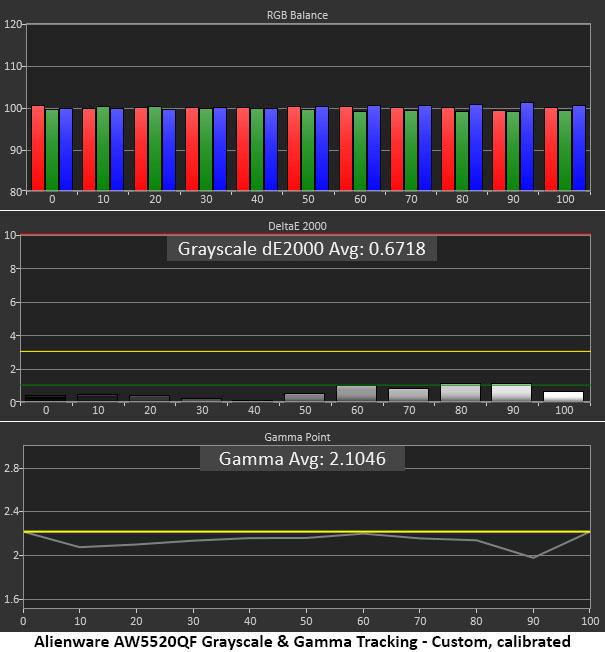
Standard mode is a good choice for SDR content. It has no visible grayscale errors, and the gamma runs close to 2.2. We wish it were a tad darker, though. There is so much contrast available that a true 2.2 or 2.3 curve would increase image depth. But that’s picking nits.
Calibrating the Custom Color (2nd chart) mode takes all the grayscale errors below 1 Delta E (dE). This is professional-level performance, but for $4,000, it should be. Gamma is still a little off the mark, however. We wish there were additional presets, since we’d rather see a higher value. That would enhance color saturation and refine highlight detail.
Comparisons
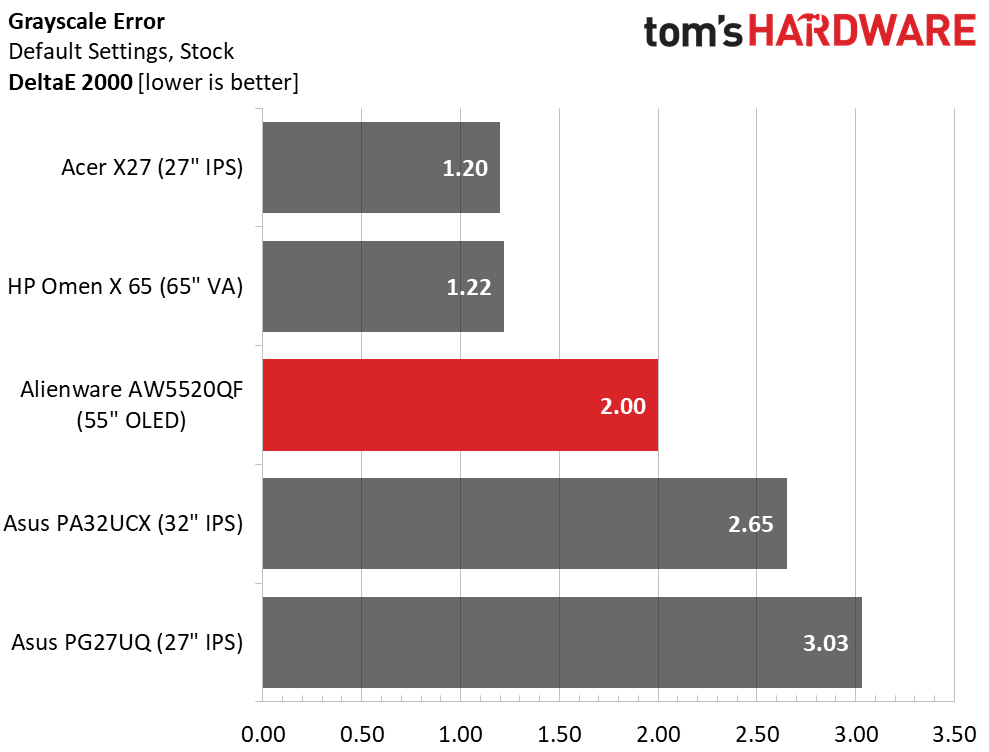
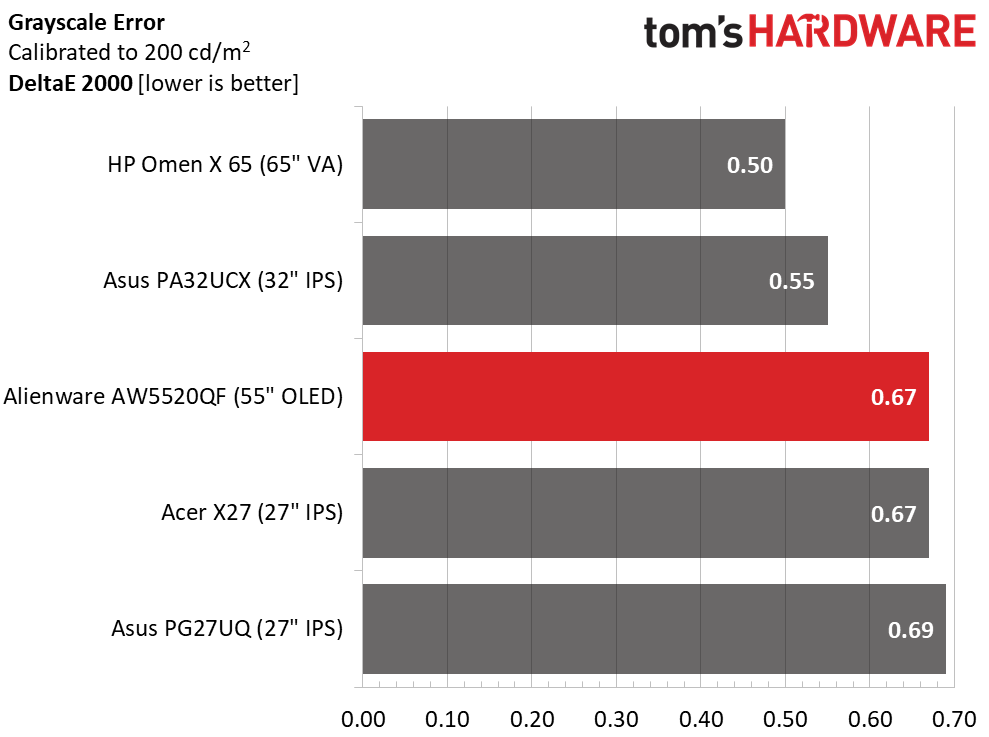
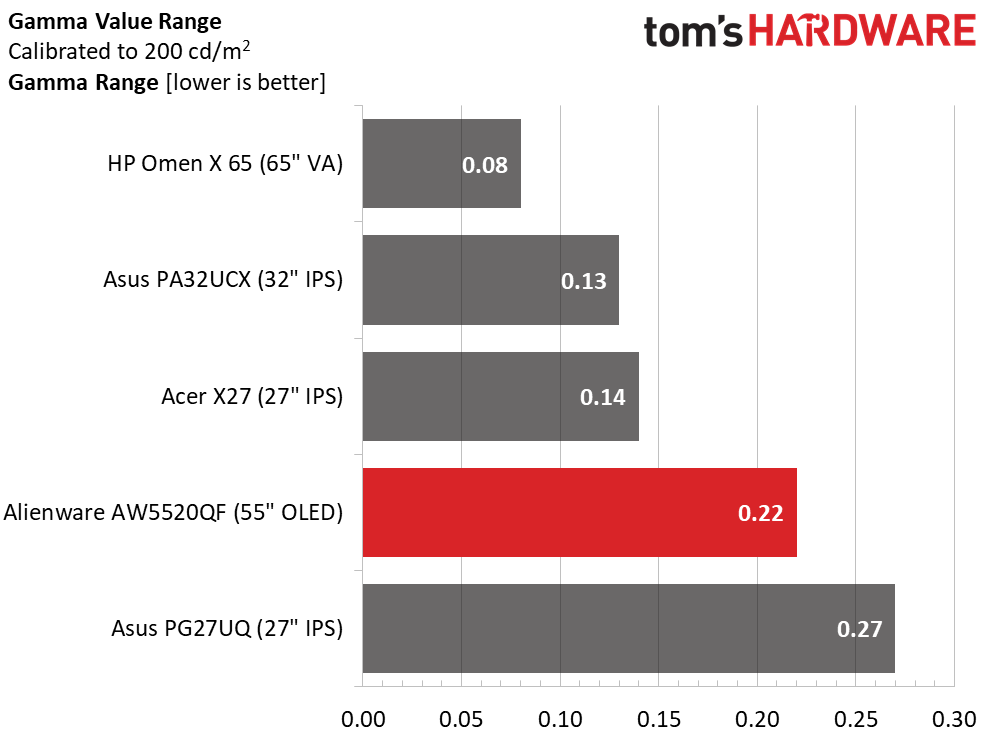
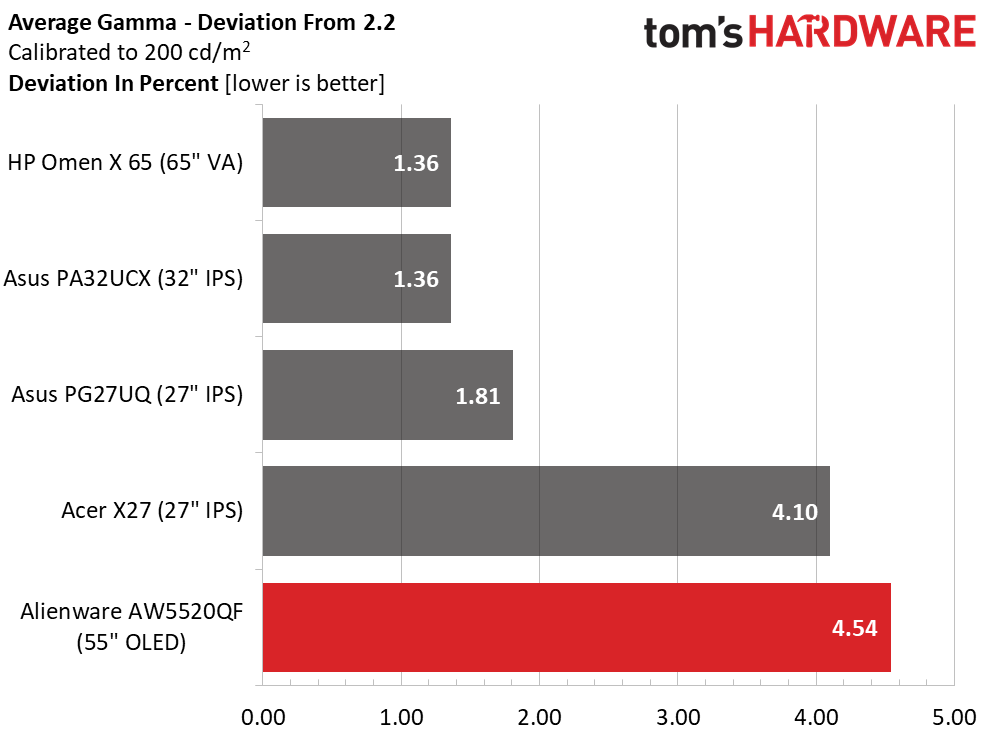
The AW5520QF is mid-pack among our comparison sample in both grayscale and gamma. However, the differences are small, so you’d be hard-pressed to see a difference when looking at the monitors side by side.
Once calibrated, the Alienware could use a tweak to its gamma. An OLED screen should measure no lower than 2.2 at any brightness step. This monitor looks amazing but isn’t performing at its full potential. This is a small thing, but for $4,000, it should be perfect.
Color Gamut Accuracy
For details on our color gamut testing and volume calculations, click here.
Get Tom's Hardware's best news and in-depth reviews, straight to your inbox.
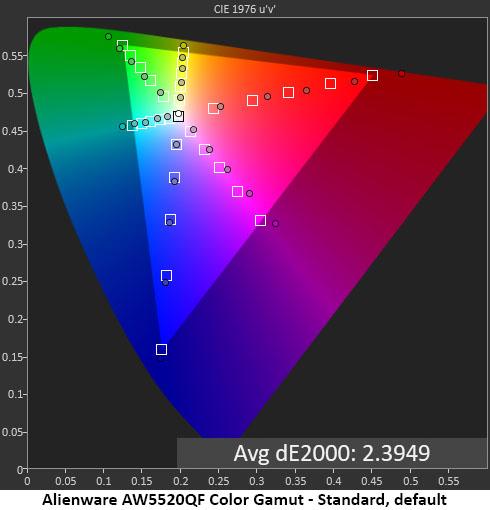


We measured all the AW5520QF’s image modes, and none of them render an sRGB color gamut. DCI-P3 is the native spec, and the monitor covers nearly all of it. That’s great for HDR-enabled material, but most games and videos are mastered to sRGB or Rec.709. There’s no reason Alienware couldn’t include the appropriate preset; users should have a choice. While the extra color looks fine in most cases, it isn’t accurate.
he out-of-box errors are measured against the sRGB gamut, and our adjustments actually increased the dE value slightly. You need sRGB for most games, since that is their mastered color gamut. This monitor is reasonably close to sRGB in terms of average error but DCI red and green are oversaturated by sRGB standards; the AW5520QF is too expensive to omit that option. Either way, you won’t see a problem, since anything below 3dE can’t be seen with the naked eye. When compared to DCI-P3, the error is just 1.26dE, an impressive result.
Comparisons
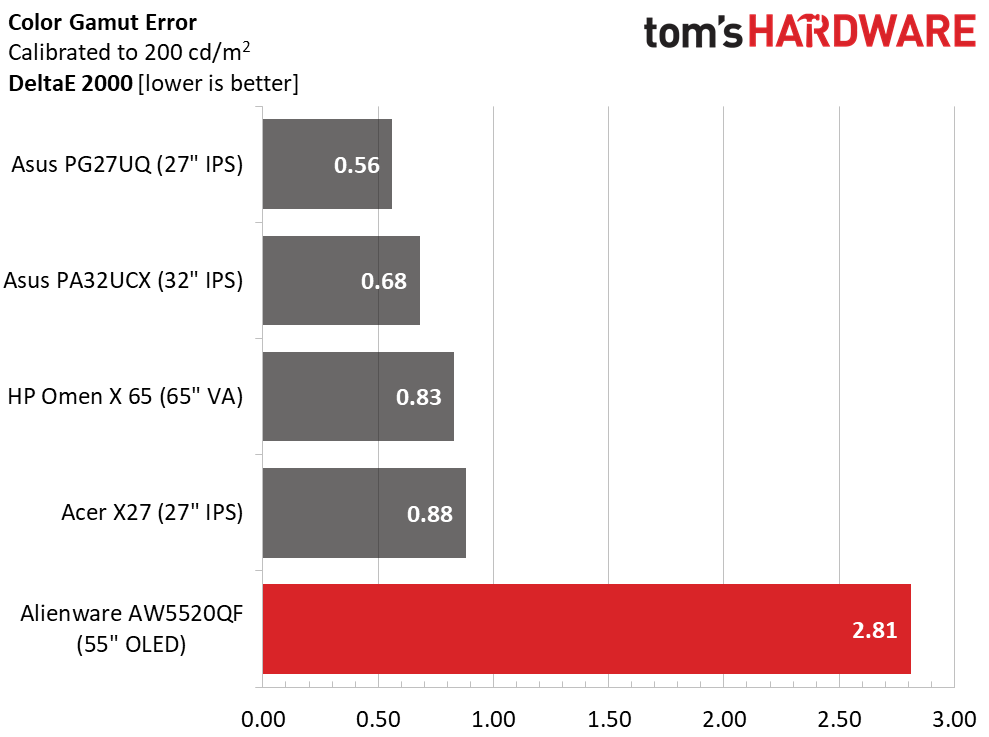
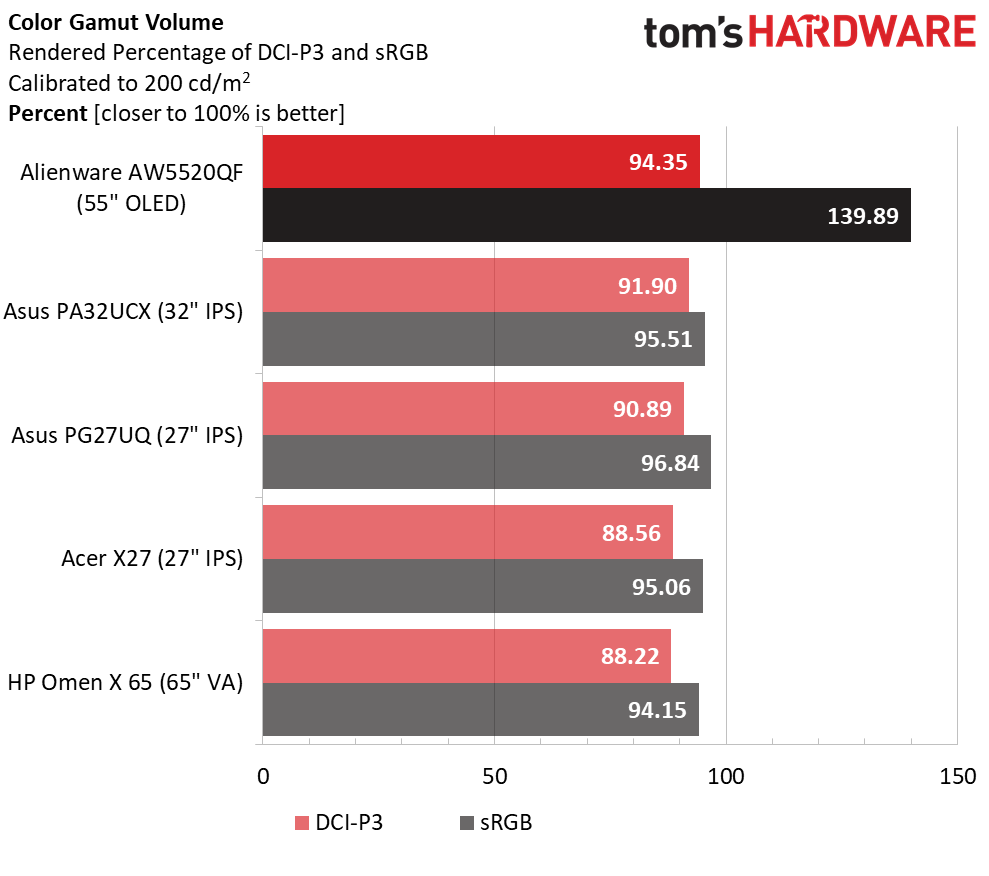
The AW5520QF came in last among our comparison sample in the sRGB gamut test, but the other monitors are impressive in their near-perfect rendering of sRGB and Rec.709. The AW5520QF doesn’t have those gamut options.
In the gamut volume calculation, Alienware managed to beat the Asus PA32UCX pro monitor. In fact, 94.35% is the largest DCI-P3 volume we’ve ever measured. Combined with the AW5520QF’s phenomenal contrast, the picture quality is quite something. Obviously, with nearly 140% coverage of the sRGB gamut, you won’t want to use this OLED for color-critical sRGB work without a color profile present to reign in the gamut.
MORE: Best Gaming Monitors
MORE: How We Test Monitors
MORE: All Monitor Content
Current page: Grayscale, Gamma and Color
Prev Page Brightness and Contrast Next Page HDR Performance
Christian Eberle is a Contributing Editor for Tom's Hardware US. He's a veteran reviewer of A/V equipment, specializing in monitors. Christian began his obsession with tech when he built his first PC in 1991, a 286 running DOS 3.0 at a blazing 12MHz. In 2006, he undertook training from the Imaging Science Foundation in video calibration and testing and thus started a passion for precise imaging that persists to this day. He is also a professional musician with a degree from the New England Conservatory as a classical bassoonist which he used to good effect as a performer with the West Point Army Band from 1987 to 2013. He enjoys watching movies and listening to high-end audio in his custom-built home theater and can be seen riding trails near his home on a race-ready ICE VTX recumbent trike. Christian enjoys the endless summer in Florida where he lives with his wife and Chihuahua and plays with orchestras around the state.
-
nitrium Is this a "monitor"? It's more like 55" TV that has Freesync. "Monitor" is the wrong word imo - "Gaming TV" is more accurate. Also OLED has terrible burn-in, so it can't be used as a regular monitor for extended periods without damaging it with ghosting. I guess if you use it solely for gaming and TV? Oh right, it's a "gaming TV".Reply -
AlistairAB As I read this, I am using my gsync compatible LG OLED TV that I bought for $1360 USD from Bestbuy. Same 120hz at 1440p, and supposedly at 4k coming next year. So the Alienware is completely pointless at its price point.Reply -
mac_angel yea, pretty much as others say, I'd be curious to see how this measures up with LG OLED, as well as the Samsung 8000 Series and up. Samsung was first with VRR (Freesync). Pay that kind of premium over these other TVs does not seem worth it by far, but I also haven't found any proper reviews directed at gaming, or specifically PC gaming. After the past few weeks of researching, I am hoping to pick up three Samsung 55" RU8000 TVs for my computer.Reply
FYI to anyone reading. If you have a good smart phone, there are pretty decent TV calibration apps you can get for your smart phone that use the camera. As good as professional equipment? No. Better than doing it by sight? Big Yes. Especially for the money. -
tharkis842 Use my C8 for gaming/pc all the time, no burn in issues. But no-one wants to hear that. This "monitor" really makes no sense though.Reply -
jacoro1 Reply
The potential for burn in on these sets has been exaggerated. I and many others have been using OLED as a primary PC monitor for extended periods for years without any burn in issues. I even disabled the static brightness limiter in the service menu on my C9, which is meant to help prevent image retention but can be irritating for PC use. Image retention on these sets is generally rare and temporary, with a few exceptions. The LG sets have automatic maintenance routines that run on a schedule to level out wear, and I suspect this Alienware display does as well. Just do common sense things like not running it in torch mode 24/7 on a static image, and maybe have a screen saver turn on after a period of inactivity.nitrium said:Is this a "monitor"? It's more like 55" TV that has Freesync. "Monitor" is the wrong word imo - "Gaming TV" is more accurate. Also OLED has terrible burn-in, so it can't be used as a regular monitor for extended periods without damaging it with ghosting. I guess if you use it solely for gaming and TV? Oh right, it's a "gaming TV".
The price on this Alienware is a bit much though. The C9 has gsync support now and can use it in HDR with double the brightness for $1400